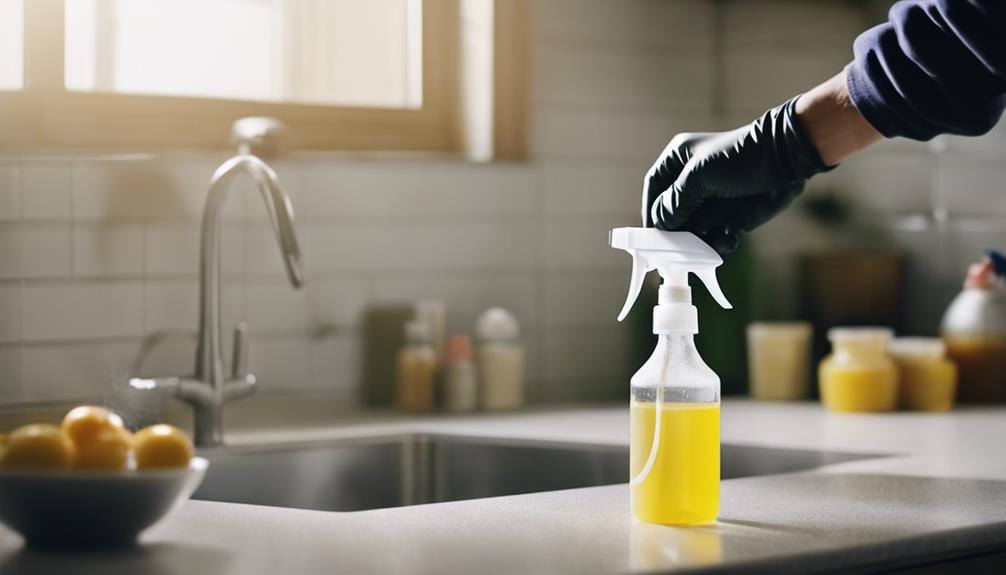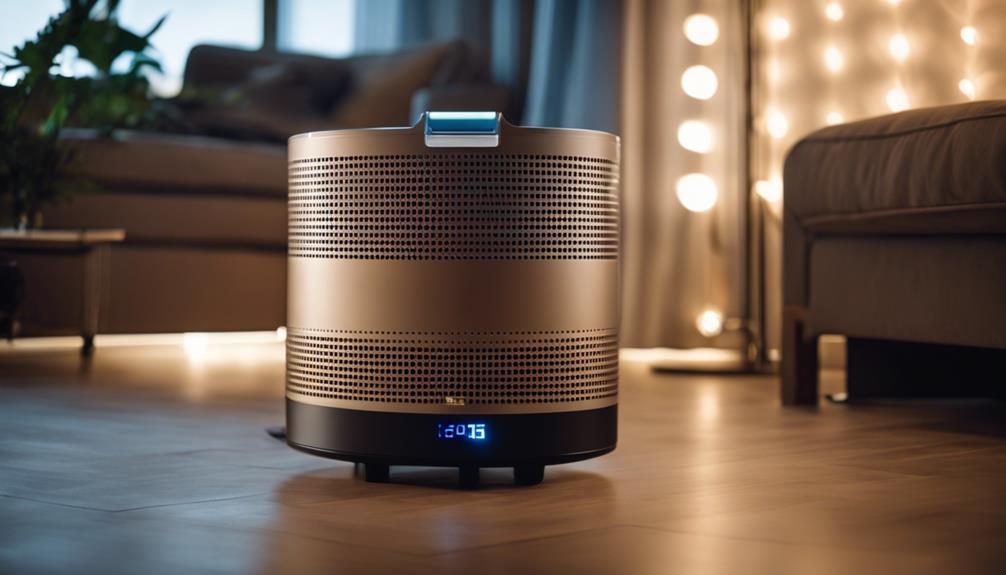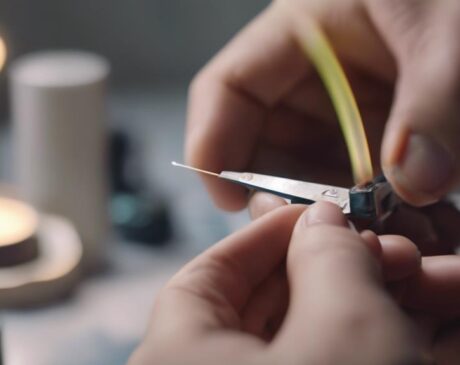What Can I Use Instead of UV Light?

In place of UV light, consider effective alternatives like chemical disinfectants, heat sterilization, photocatalytic oxidation, ozone generators, HEPA filters, ultrasonic cleaning, and silver ion technology. These options cater to diverse needs for thorough disinfection and sterilization in various settings. Each method offers unique advantages for maintaining cleanliness and safety.
Key Takeaways
- Ozone generators offer effective alternative disinfection with ozone gas.
- Chemical disinfection provides germ-killing properties without UV light.
- Silver ion technology offers continuous antimicrobial action as a UV light substitute.
- Heat sterilization is a reliable method to destroy pathogens without UV light.
- Photocatalytic oxidation improves indoor air quality by breaking down pollutants, a UV light alternative.
Chemical Disinfectants

Chemical disinfectants are widely used in various industries for their effective germ-killing properties. These powerful agents play a crucial role in maintaining safe and sanitized environments, especially in settings where UV light may not be a feasible option. The innovation in chemical disinfectants has led to the development of advanced formulas that target a broad spectrum of pathogens, ensuring thorough disinfection processes.
One notable advancement in chemical disinfectants is the introduction of eco-friendly options that are biodegradable and non-toxic, addressing concerns about environmental impact and human health. Furthermore, some disinfectants are now designed to have prolonged efficacy, providing long-lasting protection against harmful microorganisms on various surfaces.
Industries such as healthcare, food processing, and hospitality rely on chemical disinfectants to meet stringent hygiene standards and regulations. The ongoing research and development in this field continue to drive innovation, leading to the creation of more efficient and sustainable disinfection solutions. As technology advances, we can expect even more sophisticated chemical disinfectants to emerge, further revolutionizing the way we approach sterilization and sanitization processes.
Heat Sterilization
Heat sterilization, a method widely used in various industries, offers numerous benefits due to its efficiency in eliminating microorganisms. The heat treatment process involves subjecting items to high temperatures for a specified period, ensuring thorough sterilization. Understanding the thermal sterilization benefits and the intricacies of the heat treatment process is crucial for maximizing its effectiveness in different applications.
Thermal Sterilization Benefits
Thermal sterilization, known for its effectiveness in eliminating microorganisms through the application of heat, offers numerous benefits in ensuring the safety and quality of various products. This method provides a reliable way to destroy bacteria, viruses, and fungi, reducing the risk of contamination and spoilage. Unlike some chemical treatments, thermal sterilization is a natural and environmentally friendly process, making it appealing to consumers seeking sustainable options. Additionally, heat treatment can be applied to a wide range of products, including food, medical instruments, and pharmaceuticals, without altering their composition or properties significantly. Its ability to penetrate deep into materials ensures thorough sterilization, providing peace of mind to industries and consumers alike. Thermal sterilization stands as a proven and innovative solution for maintaining product integrity and safety.
Heat Treatment Process
Effective sterilization through the application of heat is a widely utilized method known for its ability to eliminate microorganisms and ensure product safety and quality. When considering heat treatment processes as an alternative to UV light, several innovative techniques can be explored:
- Dry Heat Sterilization: Utilizing hot air to eliminate microbes.
- Moist Heat Sterilization: Employing steam under pressure to achieve sterilization.
- Flame Sterilization: Directly exposing items to flames for rapid disinfection.
- Boiling Water: Submerging items in boiling water to kill bacteria and viruses.
These methods offer efficient and reliable ways to achieve sterilization without UV light, catering to the needs of various industries and applications.
Photocatalytic Oxidation

Utilizing photocatalytic oxidation is a promising method for air purification in various settings. This innovative technology harnesses the power of photocatalysts, such as titanium dioxide, to eliminate airborne pollutants. When these photocatalysts are activated by light, they create reactive oxygen species that break down organic and inorganic contaminants present in the air. This process results in the conversion of harmful substances into less harmful compounds, ultimately improving indoor air quality.
One of the key advantages of photocatalytic oxidation is its ability to target a wide range of pollutants, including volatile organic compounds, bacteria, and viruses. This makes it a versatile solution for environments where air quality is a concern, such as hospitals, offices, and residences. Additionally, photocatalytic oxidation is a sustainable technology that operates without the need for additional chemicals, making it environmentally friendly.
Ozone Generators
Ozone generators are devices that produce ozone gas for various applications, including air purification. Ozone, a powerful oxidant, is used to eliminate odors, neutralize bacteria, viruses, and mold, and break down volatile organic compounds. Here are some innovative uses of ozone generators:
- Air Purification: Ozone generators are employed in air purifiers to remove pollutants and improve indoor air quality.
- Water Treatment: Ozone can be used to disinfect water by killing bacteria and viruses, making it a valuable tool in water treatment processes.
- Food Preservation: Ozone generators help extend the shelf life of fresh produce by reducing microbial contamination.
- Laundry: In the laundry industry, ozone generators are used to disinfect and deodorize fabrics without the need for hot water or chemicals.
These applications demonstrate the versatility and effectiveness of ozone generators in various industries, showcasing their potential as an alternative solution for UV light in certain scenarios.
High-Efficiency Particulate Air (HEPA) Filters

High-Efficiency Particulate Air (HEPA) filters are advanced filtration devices commonly utilized in various industries and settings for their exceptional ability to capture small particles and airborne contaminants. HEPA filters work by forcing air through a fine mesh that traps harmful particles such as dust, pollen, pet dander, and even bacteria and viruses. These filters are known for their high efficiency in removing up to 99.97% of particles as small as 0.3 microns in size.
To highlight the effectiveness of HEPA filters, consider the following comparison table:
| Features | Benefits |
|---|---|
| Captures Small Particles | Removes allergens and pollutants from the air |
| High Filtration Efficiency | Ensures clean and fresh indoor air |
| Traps Harmful Contaminants | Improves overall air quality in homes and workplaces |
| Reduces Airborne Viruses | Helps create a healthier environment for occupants |
| Long Lifespan | Cost-effective solution for clean air filtration |
HEPA filters are a reliable and innovative solution for maintaining clean and healthy indoor air quality in various environments.
Ultrasonic Cleaning
Ultrasonic cleaning offers several advantages, such as thorough cleaning of intricate parts and delicate items without causing damage. The process involves using high-frequency sound waves to create cavitation bubbles that dislodge contaminants from surfaces. To perform ultrasonic cleaning effectively, specialized equipment like ultrasonic cleaners and appropriate cleaning solutions are essential.
Ultrasonic Cleaning Benefits
Employing the power of sound waves, ultrasonic cleaning offers a highly effective and efficient method for removing dirt and contaminants from a variety of surfaces. This innovative cleaning technique provides several benefits, including:
- Precision: Ultrasonic cleaning can reach intricate parts and crevices that are difficult to clean using traditional methods.
- Gentle Cleaning: It is a non-abrasive process that is gentle on delicate items while still providing thorough cleaning.
- Efficiency: The ultrasonic waves create millions of tiny bubbles that implode, effectively scrubbing away dirt without manual intervention.
- Time-saving: Compared to manual cleaning, ultrasonic cleaning is quicker, allowing for increased productivity and faster turnaround times.
With these advantages, ultrasonic cleaning is a cutting-edge solution for maintaining cleanliness and hygiene in various industries.
Ultrasonic Cleaning Process
The process of ultrasonic cleaning involves harnessing the power of sound waves to achieve thorough and efficient removal of dirt and contaminants from various surfaces. This innovative method uses high-frequency sound waves to create microscopic bubbles that implode upon contact with the surface being cleaned, effectively scrubbing away debris. Ultrasonic cleaning is highly effective for intricate items with hard-to-reach crevices, making it a popular choice in industries such as electronics, jewelry, and healthcare.
| Advantages | Applications |
|---|---|
| Gentle yet powerful | Electronics |
| Cleans hard-to-reach areas | Jewelry |
| Environmentally friendly | Healthcare |
Ultrasonic Cleaning Equipment
Utilizing advanced technology and precision engineering, ultrasonic cleaning equipment offers a reliable and efficient solution for removing dirt and contaminants from a wide range of surfaces.
- Precision Cleaning: Achieve thorough cleaning even in hard-to-reach areas.
- Gentle on Surfaces: Effectively clean delicate items without causing damage.
- Time-Efficient: Reduce cleaning time significantly compared to traditional methods.
- Environmentally Friendly: Eliminate the need for harsh chemicals, making it eco-friendly.
Silver Ion Technology
Silver ion technology offers a promising alternative to UV light for various applications requiring disinfection and antimicrobial properties. This innovative technology harnesses the power of silver ions to combat a wide range of pathogens effectively. By integrating silver ions into various products and materials, such as textiles, plastics, and coatings, manufacturers can create surfaces that actively inhibit the growth of bacteria, viruses, and other harmful microorganisms.
One of the key advantages of silver ion technology is its continuous antimicrobial action, which does not diminish over time. Unlike UV light, which requires direct exposure to the light source, silver ions can provide ongoing protection even in shadowed or hard-to-reach areas. This makes it a versatile solution for disinfection in various settings, including healthcare facilities, food processing plants, and consumer goods.
Furthermore, silver ion technology is known for its durability and long-lasting effectiveness, making it a cost-effective and sustainable alternative to UV light in the fight against harmful pathogens. As the demand for efficient antimicrobial solutions continues to grow, silver ion technology stands out as a cutting-edge option for ensuring cleanliness and safety in diverse environments.
Frequently Asked Questions
Are There Any Natural Alternatives to UV Light for Disinfection?
When seeking alternatives to UV light for disinfection, natural options like hydrogen peroxide, ozone, and citric acid can be considered. These alternatives offer effective disinfection properties while minimizing environmental impact, making them innovative choices for sanitation needs.
How Effective Are Ozone Generators Compared to UV Light for Sterilization?
Ozone generators and UV light are both effective sterilization methods. Ozone generators offer a chemical-free approach to disinfection, targeting airborne and surface contaminants. They can be a powerful alternative to UV light, providing comprehensive sterilization in various settings.
Can Silver Ion Technology Be Used as a Replacement for UV Light in Disinfection Processes?
Silver ion technology shows promise as an alternative to UV light for disinfection processes. Its antimicrobial properties have been effective in reducing pathogens. Further research and development are needed to optimize its use in various applications.
What Are the Potential Drawbacks of Using High-Efficiency Particulate Air (Hepa) Filters Instead of UV Light for Air Purification?
When considering air purification systems, drawbacks of using high-efficiency particulate air (HEPA) filters instead of UV light may include limited effectiveness against certain pathogens, potential for filter clogging, and the need for periodic filter replacements to maintain optimal performance.
Is Ultrasonic Cleaning a Viable Alternative to UV Light for Disinfecting Surfaces?
Ultrasonic cleaning is a promising approach for surface disinfection, utilizing sound waves to agitate a cleaning solution creating microscopic bubbles that implode, removing contaminants. Its effectiveness, cost, and ease of use make it a viable alternative to UV light.




